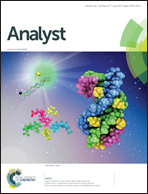A microfluidic immunoassay platform for the detection of free prostate specific antigen: a systematic and quantitative approach†
Abstract
As a leading cause of cancer-related deaths in men globally, prostate cancer (PCa) demands immense attention for theranostic purposes. There is an increasing need for the development of rapid, sensitive, economical, miniaturized and multiplexable assays. Towards this goal, we present a systematic approach for the optimisation of a microfluidic sandwich immunoassay, which can be applied as a generic biosensor platform for PCa detection. Prostate specific antigen (PSA) was used as the model biomarker, and its free form was captured using commercially available antibodies and detected using chemiluminescence, both in spiked buffer and matrix solutions. Along with the optimisation of surface chemistry and microfluidic parameters, we report a bio-affinity amplification strategy based on biotin–streptavidin chemistry to bring the limits of detection for free-PSA from 21.4 ng mL−1 down to 2.7 ng mL−1, within the clinically relevant range. An estimate of the surface coverage and simulations of the interactions taking place in the microfluidic biosensor during the assay are also presented. This novel platform using a simple passive adsorption-based bio-affinity strategy, when coupled with multiplexing and integrated detection, can serve as a promising point-of-care diagnostic tool for PCa.


 Please wait while we load your content...
Please wait while we load your content...